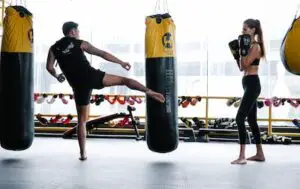Martial arts have been around for centuries and continue to be popular today for their physical and mental benefits as well as their self-defense capabilities. Two of the most widely recognized martial arts styles are karate and jiu-jitsu. Although both are formidable styles in their own right, they differ in many ways. In this article, we will explore the differences between karate and jiu-jitsu, as well as the unique benefits of each style.
What is Karate?
Karate originated in Okinawa, Japan, and entails a combination of striking, kicking, and punching techniques. In karate, practitioners utilize their feet and hands as weapons to deliver powerful blows, as well as block incoming attacks. Karate emphasizes discipline and self-control, and its practitioners strive to maintain a calm and respectful demeanor both in and outside of the dojo.
Karate also has a strong philosophy of self-improvement, as its teachings emphasize the development of not just the body, but also the mind and spirit. Through rigorous training, karate practitioners cultivate physical and mental strength, resilience, and resilience.
What is Jiu-Jitsu?
Karate and Jiu-Jitsu are both martial arts with distinct origins, philosophies, and techniques. Here are the main differences between the two:
- Origins and Philosophies:
- Karate: Karate originated in Okinawa, Japan, and was developed as a striking-based martial art. It emphasizes powerful punches, kicks, and strikes to defeat an opponent.
- Jiu-Jitsu: Jiu-Jitsu has its roots in Japan and Brazil, with different variations such as Japanese Jiu-Jitsu and Brazilian Jiu-Jitsu (BJJ). Jiu-Jitsu focuses on grappling and ground fighting techniques, aiming to immobilize or submit opponents through joint locks and chokes.
- Techniques:
- Karate: Karate techniques primarily involve strikes using the hands, elbows, feet, and knees. These techniques include punches, kicks, knee strikes, and various blocks to defend against attacks. Karate also emphasizes stances, movement, and powerful strikes.
- Jiu-Jitsu: Jiu-Jitsu techniques focus on controlling an opponent through grappling and ground fighting. Techniques involve joint locks, throws, sweeps, and submissions such as chokes and joint manipulations. Ground control and positional dominance are essential aspects of Jiu-Jitsu.
- Self-Defense vs. Sport:
- Karate: Karate encompasses both self-defense and sport aspects. Traditional karate often emphasizes self-defense techniques applicable in real-life situations. There are also karate tournaments where practitioners showcase their skills and compete.
- Jiu-Jitsu: While Jiu-Jitsu includes self-defense applications, it is predominantly practiced as a sport. Brazilian Jiu-Jitsu, in particular, gained popularity through its effectiveness in mixed martial arts (MMA) competitions. BJJ practitioners often participate in grappling tournaments and focus on sparring and ground techniques.
- Training Methods:
- Karate: Karate training involves a combination of basic techniques (kicks, punches, blocks), forms or patterns (katas), sparring, and conditioning exercises. The training often emphasizes discipline, focus, and developing striking power.
- Jiu-Jitsu: Jiu-Jitsu training includes drilling techniques, sparring (referred to as rolling), and positional training. There is a strong emphasis on learning to grapple effectively from various positions and applying submissions. Jiu-Jitsu training also places importance on flexibility, body awareness, and timing.
- Uniforms and Ranking Systems:
- Karate: Karate practitioners typically wear a karate gi (uniform) consisting of a jacket, pants, and belt. The belt system represents a practitioner’s rank, with various colored belts indicating progress and proficiency.
- Jiu-Jitsu: Jiu-Jitsu practitioners also wear a gi or a no-gi attire, depending on the training style. The belt system is similar to karate, but Brazilian Jiu-Jitsu uses a different color scheme, starting with a white belt and progressing to blue, purple, brown, and black belts.
What are the Main Differences Between Karate and Jiu-Jitsu?
The main difference between karate and jiu-jitsu is the focus of the techniques. Whereas karate emphasizes striking and blocking techniques from a standing position, jiu-jitsu focuses on ground fighting and grappling techniques. This means that karate practitioners spend more time practicing their kicks and punches, whereas jiu-jitsu practitioners focus more on takedowns, submissions, and controlling an opponent.
Karate also tends to be more formal and traditional in its approach compared to jiu-jitsu. Karate practitioners often wear traditional Japanese uniforms (gi) and follow strict etiquette within the dojo, emphasizing respect and discipline. Jiu-jitsu, on the other hand, tends to be more relaxed in its approach, with less emphasis on formality and more emphasis on practicality.
What are the Benefits of Karate?
Karate offers many benefits, including improved physical fitness, increased focus and concentration, and self-defense skills. Its emphasis on discipline and self-control promotes stress management, enhances mental resilience, and cultivates confidence and self-esteem.
Karate training requires intense physical conditioning, which can help improve cardiovascular health, strengthen bones and muscles, and increase flexibility. Additionally, through its emphasis on the development of the mind and spirit, karate can teach valuable life skills such as goal setting, conflict resolution, and empathy.
What are the Benefits of Jiu-Jitsu?
Jiu-jitsu also offers many benefits, including improved physical fitness, increased mental focus and concentration, and self-defense skills. Jiu-jitsu can help build strength, endurance, and power, and it trains practitioners to be comfortable in close quarters and on the ground.
Jiu-jitsu also requires intense mental focus, which can help improve concentration, perseverance, and problem-solving skills. Additionally, jiu-jitsu training promotes stress management, self-discipline, and self-confidence, as students learn to face and overcome challenges both on and off the mat.
Which Style is Best for Self-Defense?
Choosing a martial art for self-defense depends on individual preferences, goals, and circumstances. Both karate and jiu-jitsu are effective for self-defense, and each has its own unique advantages.
Karate is effective for defending against multiple attackers in open spaces, as its striking techniques allow practitioners to keep opponents at a distance. Jiu-jitsu, on the other hand, is effective for defending against attackers in close quarters, as its grappling techniques allow practitioners to control an opponent on the ground.
Conclusion
Ultimately, the best martial art for self-defense is the one that resonates with an individual’s goals, preferences, and lifestyle. Whether one chooses to practice karate or jiu-jitsu, both styles offer physical and mental benefits that can promote overall well-being and resilience.





